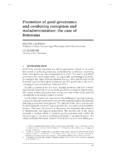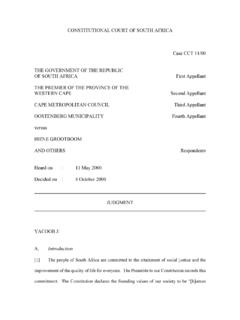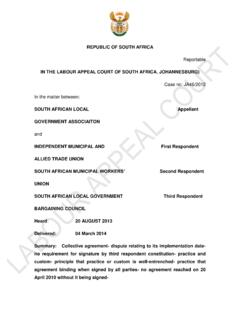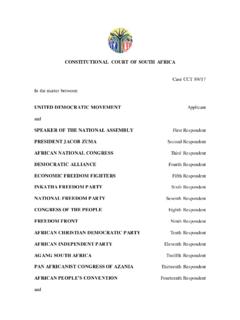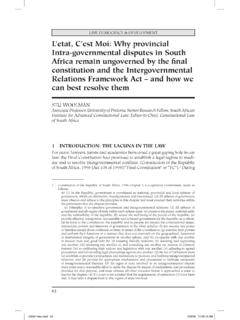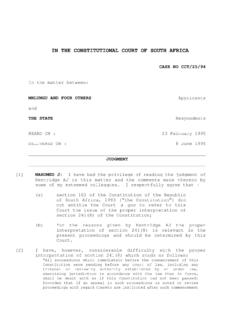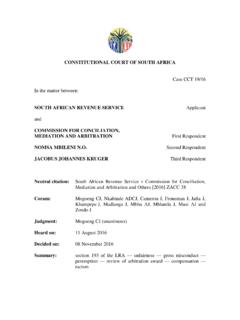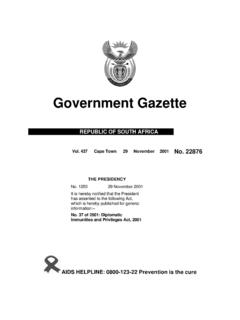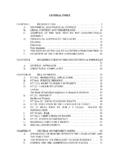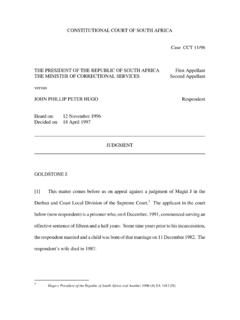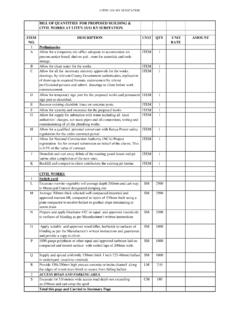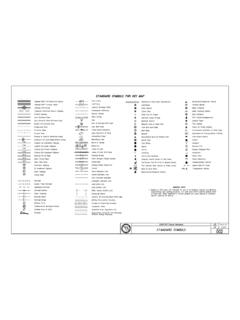Transcription of MINE HEALTH AND SAFETY ACT MINE HEALTH AND SAFETY …
1 MINE HEALTH AND SAFETY ACT Act 29 of 1996. MINE HEALTH AND SAFETY REGULATIONS [Updated to 10 July 2015] GoN R93, G. 17725 ( 15 January 1997), GoN R846, G. 18078 ( 21 June 1997), GoN R1315, G. 19354 (16 October 1998), GoN R721, G. 20155 ( 11 June 1999), GoN R1486, G. 20714 (corrected by GoN R303, G. 21029) ( 17 December 1999), GoN R134, G. 22055 ( 9 February 2001), GoN 786, G. 23498 ( 14 June 2002), GoN R787, G. 23498 ( 14 June 2002), GoN R904, G. 23583 ( 2 July 2002 unless otherwise specified), GoN R907, G. 23586 ( 2 July 2002), GoN R569, G. 23410 ( 1 September 2002), GoN R1573, G. 24168 ( 13 December 2002), GoN R1579, G. 24168 ( 13 December 2002), GoN R959, G. 23615 ( 1 January 2003), GoN R886, G. 25097 ( 20 June 2003), GoN R1237, G. 25404 ( 29 August 2003), GoN R1792, G. 25812 ( 12 December 2003), GoN R583, G. 26333 ( 14 May 2004), GoN 783, G. 26496 ( 2 July 2004), GoN R1304, G. 26963 (corrected by GoN R89, G.)
2 30698) ( 12 November 2004), GoN R1323, G. 26963 ( 12 November 2004), GoN R1224, G. 28333 (corrected by GoN R 90, G. 30698) ( 15 December 2005), GoN R1225, G. 28333 (corrected by GoN R 90, G. 30698) ( 15 December 2005), GoN R1226, G. 28333 ( 15 December 2005), GoN 911, G. 29214 ( 8 September 2006), GoN R989, G. 29276 ( 5 October 2006), GoN 34, G. 29544 ( 19 January 2007), GoN R1279, G. 29458 ( 1 July 2007), GoN 86, G. 30697 ( 1 February 2008), GoN R92, G. 30698 ( 1 February 2008), GoN R93, G. 30698 ( 1 February 2008), GoN R94, G. 30698 ( 1 February 2008), GoN R1053, G. 33752 ( 12 November 2010), GoN R1068, G. 33763 ( 19 November 2010), GoN R447, G. 34308 ( 27 May 2011), GoN R621, G. 36761 ( 23 August 2013), GoN R622, G. 36761 ( 23 August 2013), GoN R701, G. 37980 ( 12 September 2014), GoN R702, G. 37980 ( 12 September 2014), GoN R906, G. 38216 ( 21 November 2014), GoN R330, G. 38708 ( 24 April 2015), GoN R332, G.
3 38708 ( 24 April 2015), GoN R125, G. 38493 ( 27 May 2015 unless otherwise specified), GoN R584, G. 38970 ( 10 October 2015). Under section 98 of the Mine HEALTH and SAFETY Act, 1996 (Act 29 of 1996), I, Penuell Mpapa Maduna, Minister of Minerals and Energy, hereby make the regulations in the Schedule. (Signed) P. M. MADUNA Minister of Minerals and Energy SCHEDULE ARRANGEMENT OF REGULATIONS Chapter 1: Appointments and Administration Chapter 2: Duties and Responsibilities Chapter 3: Electricity Chapter 4: Explosives Chapter 5: Fires and Explosions Chapter 6: HEALTH and SAFETY Representatives and Committees Chapter 7: Inspectorate of Mine HEALTH and SAFETY Chapter 8: Machinery and Equipment Chapter 9: Mine Environmental Engineering and Occupational Hygiene Chapter 10: Miscellaneous and General Provisions Chapter 11: Occupational HEALTH Chapter 12: Offshore Installations Chapter 13: Outlets, Ladderways and Travelling Ways Chapter 14: Protection of the Surface and the Workings Chapter 15: Qualifications and Competencies Chapter 16: Rescue, First Aid and Emergency Preparedness and Response Chapter 17: Surveying, Mapping and Mine Plans Chapter 18: Tripartite Institutions Chapter 19: Underwater Mining Chapter 20.
4 Definitions Chapter 21: Forms Comment [l1]: Not available in the content Chapter 22: Schedules Chapter 23: Reporting of Accidents and Dangerous Occurrences [Arrangement of Regulations subs by Sch in GoN R907 in G. 23586, GoN R1573 in G. 24168.] CHAPTER 1 APPOINTMENTS AND ADMINISTRATION [An italicised word or phrase is defined in section 102 of the Act and such word or phrase in bold is defined in Chapter 20 of these Regulations.] Prescribed period for representations (1) Representations invited by the Principal Inspector of Mines as contemplated in section 55D(1)(b) must be submitted to the Principal Inspector of Mines within 30 days of the date of the invitation or within such further period or periods as the Principal Inspector of Mines may determine. Prescribed period for payment of fine (1) A fine imposed on an employer in terms of section 55D, must be paid to the Principal Inspector of Mines within 60 days of the date on which the fine was imposed or within such further period or periods as the person or court imposing the fine, may determine.
5 (2) The date on which the fine is imposed is regarded as the date on which notification of the administrative fine was served on the employer by (a) hand; (b) registered post; or (c) any other form of communication agreed to between the employer and the Principal Inspector of Mines. [Chapter 1 ins by Sch of GoN R1315 in G. 19354.] Editor Note: Please note that regulations to of the regulations published under GNR 992 of 1970 are to be repealed with effect from the publication in the Gazette of Chapter 2 of these Regulations See GNR 446 in Government Gazette 34308 of 27 May 2011. CHAPTER 3 ELECTRICITY DEFINITIONS Comment [l2]: Checked GNR446. It says The repeal of the regulations mentioned in clause 1 above shall take effect on the date on which the relevant new regulations are published in the government gazette Here chapter 2 is removed. In these Regulations, unless the context indicates otherwise Accredited Test Laboratory (ATL) means an organisation that is accredited by the South African National Accreditation System (SANAS).
6 Arc Flash means an uncontrolled electrical discharge through the air between conductors or between a conductor and earth. The resulting discharge of energy can result in fire, serious damage to electrical apparatus and injury or death to a person. Armouring means a metallic covering of an electric cable, in the form of tape, wire or tube enclosing one or more conductors to provide adequate mechanical protection against damage. Bus-coupler means a device, or set of devices, needed to facilitate the connection of two parallel circuits. Bus-section means a device, or set of devices, that will extend a bus-bar to another. Circuit means an interconnection of electrical elements such as resistors, inductors, capacitors, transmission lines, voltage sources, current sources and switches which have a closed loop giving a return path for the current. Clearance means a minimum distance any part of a person s body or any work tool may encroach to any unearthed, bare conductor or to any unearthed and unscreened conductor.
7 Collectively Screened means having a conductive covering enclosing all power conductors as well as all control conductors within the protective outer sheath of a cable. Conductor means any substance or material which can transfer an electrical charge along or through it and is connected to an electrical circuit. Dead means at or about zero potential with respect to the general mass of earth and disconnected from any live reticulation system. Domestic Voltage means a voltage not exceeding 230V 10% alternating current phase to neutral. Earthed means connected to the general mass of earth in such a manner as will ensure at all times an immediate discharge of electrical energy without risk. Electrical Apparatus means any apparatus, machine and fitting in which conductors are used, or of which they form a part. Electrical Single-Line Diagram means a diagram that shows, by means of single lines and graphic symbols, the general layout of an electric circuit or system of circuits.
8 Flexible cable means a cable of which the conductors consist of strands of diameter not exceeding 0,51 mm and of which the insulation and covering are such that they afford flexibility and in which the nominal cross sectional area of each conductor exceeds 4 mm2, but shall not include signalling cable, telephone cable, blasting cable, or flexible cord used with electric apparatus at a voltage not exceeding domestic voltage alternating current on a single phase system. Flexible cord means a cable of which the nominal cross sectional area of each conductor does not exceed 4 mm2 and of which each conductor consists of strands of diameter not exceeding 0,31 mm. Hazard Classification A system developed for categorising electrical hazards based on the voltage and fault level ratings for electrical components. High Voltage (HV) a set of nominal voltage levels in the range 44 kV and above to 220 kV.
9 Individually Screened means having a conductive covering enclosing power conductors individually within the protective outer sheath of a cable. Isolation means disconnecting the apparatus from all possible sources of electrical potential and locking the apparatus in such a manner so that no energisation can take place. Insulated means covered with any material that has the characteristic of low electrical conductivity such as to prevent an electrical discharge. Live means electrically charged. Lockout-tagout (LOTO) or lock and tag is a SAFETY procedure which is used to ensure that machines / switchgear and Electrical equipment are properly isolated, de-energised and tagged. Low Voltage (LV) means a set of nominal voltage levels that are used for the distribution of electricity, the upper limit of which is an voltage of 1000V or a voltage of 1 500 V. Medium Voltage (MV) means a set of nominal voltage levels above the range of 1 000 V to below 44 kV.
10 Metallic Covering means iron or steel armouring or metal conduit surrounding two or more conductors with or without a lead or other metallic sheath as required in terms of operational conditions. Moveable Electrical Apparatus means electrical apparatus, excluding self-propelled mobile machines or portable electrical apparatus, which is not installed on permanent foundations and is intended to be moved from place to place. Overhead Power Line means an overhead line erected to convey electrical energy for any purpose other than communication but excluding the overhead contact or catenary wires of an electrical traction system. Permit to Work is a formal, written, safe system of work to control potentially hazardous activities. The permit details the work undertaken and the necessary precautions to be taken. Portable Electric Apparatus means electric apparatus, which is designed to be carried by hand, and may require electric power while being used.
